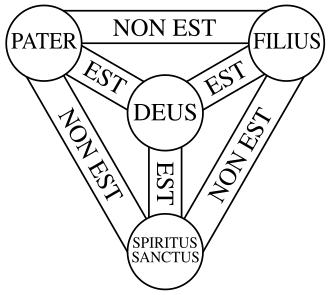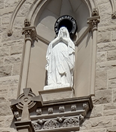Holy Trinity: Difference between revisions
Appearance
| Line 50: | Line 50: | ||
** Romans considered Christians atheistic, as they rejected Roman gods and refused to worship Caesar | ** Romans considered Christians atheistic, as they rejected Roman gods and refused to worship Caesar | ||
** gnostics and other heretics believed that Jesus fully God and not a Man, thus he was either not a man or not God | ** gnostics and other heretics believed that Jesus fully God and not a Man, thus he was either not a man or not God | ||
* St. Thomas Aquinas | |||
* | == Shield of the Trinity (''Scutum Fidei)'' == | ||
[[File:Shield-Trinity-Scutum-Fidei-compact.svg|left|thumb|Basic "Shield of the Trinity" diagram (wikipedia)]] | |||
[[File:Shield-Trinity-Scutum-Fidei-variations.svg|thumb|Four variants of the "Shield of the Trinity"]] | |||
* derived from the Athanasian Creed | |||
* God (DEUS) is at the center | |||
* the three Persons are at the corners | |||
* the shiled was consiered the "Herald of God" | |||
=== The forumulation of the Shield === | |||
* note that all the links (connections) are bi-directional (go both ways) | |||
* EST means "is" | |||
* NON EST means "is not" | |||
Thereby: | |||
* "The Father is God" | |||
* "The Son is God" | |||
* "The Holy Spirit is God" | |||
* "God is the Father" | |||
* "God is the Son" | |||
* "God is the Holy Spirit" | |||
* "The Father is not the Son" | |||
* "The Father is not the Holy Spirit" | |||
* "The Son is not the Father" | |||
* "The Son is not the Holy Spirit" | |||
* "The Holy Spirit is not the Father" | |||
* "The Holy Spirit is not the Son" | |||
== St. Thomas Aquinas on the Trinity == | |||
St. Thomas Aquinas thought deeply about the Trinity in ''Summa Theologica'' | |||
* his thought extends from the concepts of the Trinity and the Oneness of God: | |||
* One God | |||
* Two Processions | |||
*# The Father > The Son (Generation) | |||
*# The Father and The Son > Holy Spirit (Spiration) | |||
** Three Persons | |||
**# The Father | |||
**# The Son | |||
**# The Holy Spirit | |||
** Four Relations | |||
**# The Father > The Son = ''Paternity'' | |||
**# The Son < The Father = ''Filiation'' | |||
**# The Father and The Son > The Holy Spirit = ''Active Spiration'' (originiation) | |||
**# The Father and The Son < The Holy Spirit = ''Passive Spiration'' (procession) | |||
** Five Notions | |||
**# The Father > innascibility or unbegottennes | |||
**# The Father > paternity, i.e. The Father > The Son | |||
**# The Father and The Son "spirate" the Holy Spirit | |||
**# The Son = both Filiation and Spiration | |||
**# The Holy Spirit = Procession | |||
** notes: | |||
*** St. Thomas wrote in ''Summa Theologica'', | |||
**** ''"Although there are four relations in God, one of them, spiration, is not separated from the person of the Father and of the Son, but belongs to both;"'' | |||
*** these relations, originatinos, and processions are internal to God and not related to temporal process (outside of time) | |||
*** See: | |||
**** Univ Notre Dame: [https://www3.nd.edu/~afreddos/courses/417/trinityhandout.pdf trinityhandout.pdf] | |||
**** [https://catholicism.org/the-relations-in-the-blessed-trinity.html The 'Relations' in the Blessed Trinity - Catholicism.org] | |||
**** [https://prodigalcatholic.com/summary-of-chapter-23-trinitarian-relations-and-notional-names-of-persons-from-whites-book-the-trinity/ Summary of Chapter 23: Trinitarian Relations and Notional Names of Persons (from White’s book, The Trinity) – Prodigal Catholic] | |||
Revision as of 11:25, 29 May 2024
The "Trinity" or, "Holy Trinity" of the Father, the Son, and the Holy Spirit
- note: see glossary entry on "Holy"
The Holy Trinity is called collectively the "Godhead" or the "Triune"
- also, the "Blessed Trinity"
Terminology of the Trinity
Godhead
The Trinity may also be referred to as the "Godhead"
- = God in the full nature of the Trinity
- from Middle English God + hede (nature of)
- note: the Father is the "source and origin" of the Godhead, but the Godhead indivisibly consists of the Father, the Son and the Holy Spirit
- see CCC 2789
hypostasis
refers to the "Persons" of God; in Latin persona
- from Greek for "substance"
- from hypo- (under) + stasis (standing or position)
- "hypostatic union" refers to the "union of the divine and human natures... of the Son of God, Jesus Christ" (CCC Glossary)
Triune
a similar reference to "Godhead" for the Holy Trinity
- but also used as an adjective, as in "the Triune God"
Athanasian Creed
or Quicunque vult
- an important early Church statement and explanation of the Holy Trinity
- from from CCC 266
"Now this is the Catholic faith: We worship one God in the Trinity and the Trinity in unity, without either confusing the persons or dividing the substance; for the person of the Father is one, the Son's is another, the Holy Spirit's another; but the Godhead of the Father, Son and Holy Spirit is one, their glory equal, their majesty coeternal" (Athanasian Creed: DS 75; ND 16).
- See
- The "Athanasian" Creed (slightly different translation from EWTN)
- encyclopedic entry Heinrich Denzinger and his work, "Handbook of Creeds, Definitions and Declarations on matters of faith and morals"
The Trinity
The Holy Trinity is the mystery of God in three Persons: Father, Son, and Holy Spirit
- the Trinisy consists of the
- Persons of God: Father Son and Holy Spirit
- Natures of God: Creator, Redeemer, and Sanctifier
- the Trinity was source of much conflict and contention in the early Church
- and, ultimately, a core tenant of Church doctrine
- Jews were offended that fellow Jews worshiped Christ, as Judaism was supposed to be monotheistic
- Romans considered Christians atheistic, as they rejected Roman gods and refused to worship Caesar
- gnostics and other heretics believed that Jesus fully God and not a Man, thus he was either not a man or not God
Shield of the Trinity (Scutum Fidei)


- derived from the Athanasian Creed
- God (DEUS) is at the center
- the three Persons are at the corners
- the shiled was consiered the "Herald of God"
The forumulation of the Shield
- note that all the links (connections) are bi-directional (go both ways)
- EST means "is"
- NON EST means "is not"
Thereby:
- "The Father is God"
- "The Son is God"
- "The Holy Spirit is God"
- "God is the Father"
- "God is the Son"
- "God is the Holy Spirit"
- "The Father is not the Son"
- "The Father is not the Holy Spirit"
- "The Son is not the Father"
- "The Son is not the Holy Spirit"
- "The Holy Spirit is not the Father"
- "The Holy Spirit is not the Son"
St. Thomas Aquinas on the Trinity
St. Thomas Aquinas thought deeply about the Trinity in Summa Theologica
- his thought extends from the concepts of the Trinity and the Oneness of God:
- One God
- Two Processions
- The Father > The Son (Generation)
- The Father and The Son > Holy Spirit (Spiration)
- Three Persons
- The Father
- The Son
- The Holy Spirit
- Four Relations
- The Father > The Son = Paternity
- The Son < The Father = Filiation
- The Father and The Son > The Holy Spirit = Active Spiration (originiation)
- The Father and The Son < The Holy Spirit = Passive Spiration (procession)
- Five Notions
- The Father > innascibility or unbegottennes
- The Father > paternity, i.e. The Father > The Son
- The Father and The Son "spirate" the Holy Spirit
- The Son = both Filiation and Spiration
- The Holy Spirit = Procession
- notes:
- St. Thomas wrote in Summa Theologica,
- "Although there are four relations in God, one of them, spiration, is not separated from the person of the Father and of the Son, but belongs to both;"
- these relations, originatinos, and processions are internal to God and not related to temporal process (outside of time)
- See:
- St. Thomas wrote in Summa Theologica,
